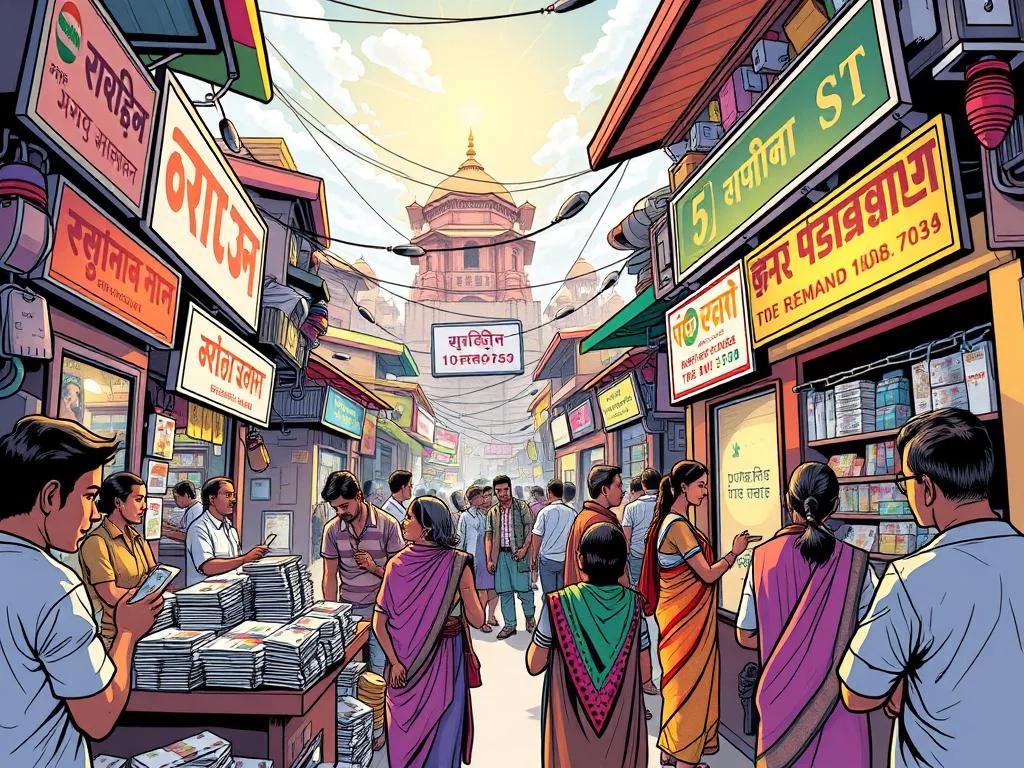Traveling to India? Knowing about currency exchange can save you money and time. The Indian Rupee, or “₹” and INR, is split into 100 paise. You’ll find notes in 5, 10, 20, 50, 100, 200, 500, and 2,000 rupees. Coins range from 1 to 10 rupees, but smaller paise coins are less common.
The Indian rupee is special because it shows national landmarks like the Taj Mahal. It’s also printed in many languages, showing India’s cultural diversity. Carrying smaller rupee denominations is smart for rural or remote areas.
India’s peak travel season is from November to February. This time, prices for places to stay and travel go up. To save money, use online currency exchange services or ATMs. These often have better rates. With these tips, your trip to India can be both fun and affordable.
Understanding the Indian Rupee
The Indian rupee (INR) is the official currency of India, symbolized as ₹. It is divided into 100 smaller units called paise. Today, rupee notes come in denominations from ₹5 to ₹2000. Coins are available in 1, 2, 5, and 10 rupee values.
The rupee’s history goes back to the 6th century BCE. It started with silver punch-marked coins during the Mahajanapadas period. The “rupiya” was introduced by Sher Shah Suri in the 16th century.
The rupee became official in 1835 during British rule. After India gained independence in 1947, the rupee remained the official currency. Knowing its history and current use is important.
For those transferring currency, platforms like Wise offer essential details. They provide information on transferring Indian money, including account numbers and IFSC codes. Understanding rupee denominations and their history is key for anyone dealing with India’s financial scene.
How to Exchange Currency in India
Exchanging currency in India can be tricky, but there are ways to get a good deal. You can exchange USD, GBP, and EUR at airports, hotels, and banks. But, the rates and fees vary a lot depending on where you go.

ATMs are a good choice for exchanging money. They offer good rates and are found in cities. It’s smart to take out a lot of money at once to avoid extra fees.
Exchanging money at airports or hotels might seem easy, but it’s not the best option. Banks or local exchange bureaus in cities usually have better rates. Using reputable banks or services like Western Union is safer and more cost-effective.
Here are some key tips for exchanging currency and using money transfer services in India:
- Avoid Unregulated Changers: Stick to authorized money changers to avoid scams.
- Check Exchange Rates: Compare rates to find the best deal.
- Use ATMs Wisely: Take out big amounts to save on fees.
- Bank Transfers: Consider bank transfers for their safety and rates.
| Method | Pros | Cons |
|---|---|---|
| ATMs | Favorable exchange rates, convenient | Fixed transaction fees |
| Airports & Hotels | Convenient | Less favorable rates |
| Banks | Secure, good rates | May require visit during business hours |
| Western Union | Widely accessible, secure | Service fees may apply |
Following these tips can make exchanging currency in India easier and cheaper. Being careful and informed helps you get rupees at good rates and avoid extra costs.
Guide to Receive International Payments in India
Getting international payments in India is easy with the right tools and knowledge. It doesn’t matter if you’re an individual or a business. Knowing how foreign transfers work in India is key.
In India, there are rules for bringing in foreign money. You don’t need to declare money up to USD 5,000 or its equivalent. But, if you have more, you must declare it when you enter the country. This helps you follow the rules when making foreign transfers in India.
Services like Western Union make it easy to receive money in India. They have many locations across the country. You can quickly get your money. Also, banks like HDFC and ICICI can handle big international payments. Make sure to check their fees and conditions before you start.
Using popular payment gateways can make foreign transfers easier. Razorpay, PayPal, and Payoneer are good choices because they are reliable and fast. Razorpay is great for businesses because it lowers costs and speeds up payments. You can even open foreign currency accounts with Razorpay right away.

It usually takes 5-6 business days to get international payments in India. SWIFT payments take 1-5 working days. But, some platforms like VBAN can send money in just one business day.
Tell your local bank about any international payments you’re expecting. This helps avoid any issues with your account. The RBI and Foreign Exchange Management Act (FEMA) make sure everything is safe for both the sender and the receiver.
For businesses, making international payments is very important. In 2023, Indian SMEs made up 43.59% of all exports. This number is expected to grow to 60% by 2030. Being able to handle international payments well is key for businesses to succeed globally.
Here’s a quick comparison of key aspects that influence the choice of payment gateway:
| Payment Gateway | Transaction Cost | Processing Time | Reliability |
|---|---|---|---|
| Razorpay | Low | Fast | High |
| PayPal | Moderate | Medium | High |
| Payoneer | Low | Fast | High |
By using the right tools and following the rules, managing international payments in India is easy. This helps businesses and individuals to confidently take part in the global economy.
Tips and Tricks for Managing Currency in India
Managing money in India well means knowing local ways and key tips. Remember, small rupee amounts are great for daily buys, tips, and places without credit card use. In crowded markets or rural spots, cash in smaller amounts helps avoid trouble.
It’s smart to carry different ways to pay, like cash, cards, and traveler’s checks. With more people using digital payments, options like PayPal, Apple Pay, and Google Pay are popular. But, also keep traditional ways ready for any situation.
Keep an eye on exchange rates and rate changes to get better deals. Always get and keep your exchange receipts. They’re key for converting rupees back to your currency when leaving India. For more on handling foreign money, check out this guide for RBI rules.
Knowing local customs is key for money management in India. In cities and with fancy services, a 10% tip is common. But, in smaller places, tipping is rare. Adjusting your tips shows respect and helps manage your rupees wisely.

